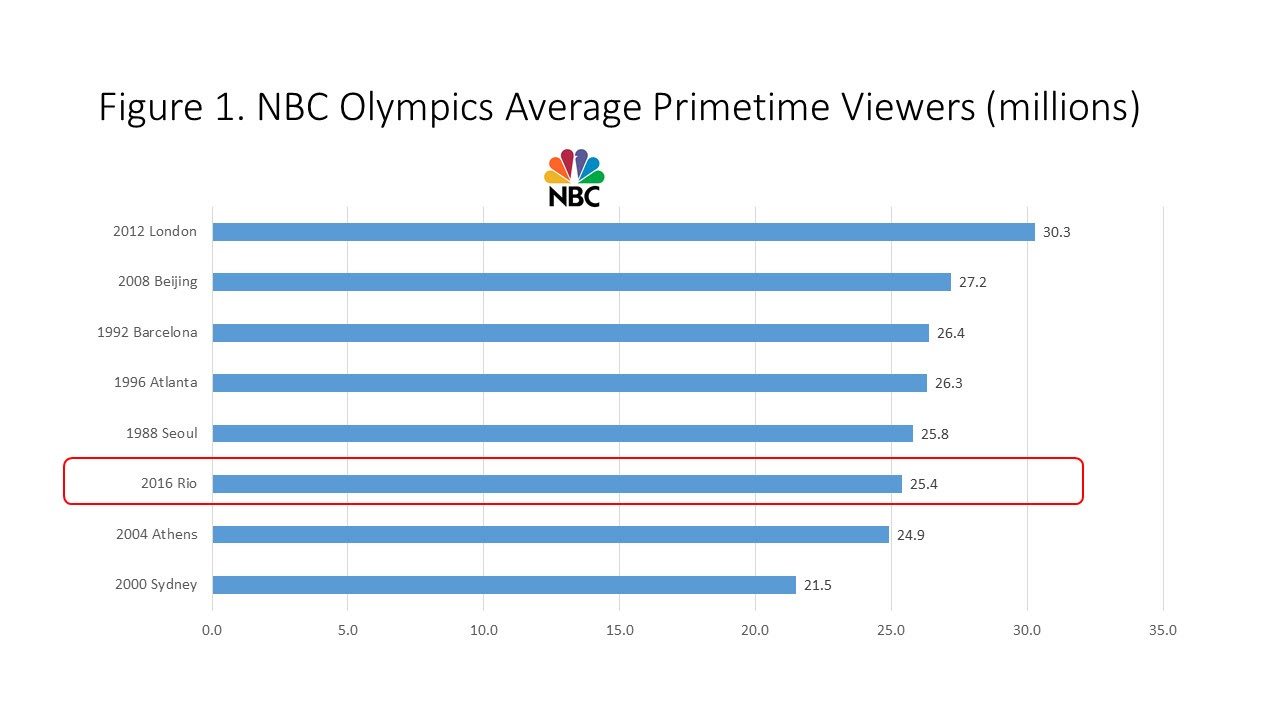Traditional TV broadcast generates the most viewers, but video streaming to mobile devices is growing fast
The recently held Olympics in Rio de Janeiro, Brazil, were certainly very exciting with out-of-this-world performances by Michael Phelps, Katie Ladecky, Simone Biles and Usain Bolt just to name a few. There was also a new world record established for steaming of video from Rio. NBC stated there were more than 2.7 billion minutes of live streamed video during the 16 days of competition. This was nearly double the combined live-streamed total for all of the previous Olympics put together.
So, when NBC reported the average number of primetime TV viewers, it is easy to understand the viewer statistics from Rio were substantially lower than in previous Olympics. Take a look at Figure 1. You can see that the average number of prime-time viewers as reported by NBC was 25.4 million, which put the 2016 Games in fifth place and only ahead of Athens in 2004, and Sydney in 2000. Clearly, streaming of video to mobile devices, laptops and personal computers are beginning to play an important role on how people are watching the Olympics.

From Figure 1, there’s more than meets the eye. First, if you look at the data in chronological order, you can see that average prime-time viewership grew very nicely from 21.5 million average viewers in 2000 (Sydney), to 24.9 million in 2004 (Athens), 27.2 million in 2008 (Beijing), to 30.3 million 2012 (London). Then, there are the 1992 Games in Barcelona, Spain, that had 26.4 million and the 1996 Games in Atlanta with 26.3 million that didn’t fit the mold. On one hand, you’d think the 1996 Games would have the highest average prime-time viewership ever since it was held in the U.S., but it also was being broadcast in real time that likely spoiled prime-time TV viewership.
The big decline, of course, is the drop in prime-time TV viewership from 2012 (London) to 2016 (Rio). A good portion of this is due to young people using both laptops and tablets to view events in real time rather than waiting for the replay show in the evening.
NBC reported most of the viewing of streaming video was on laptops and tablets not smartphones. This makes sense since the tablet and laptop have larger displays. It’s far better to view streaming video on an iPad than an iPhone (same for Samsung smartphones and tablets). NBC charged double for ads on mobile devices (iOS, Android native apps and mobile web access) since these devices made it easier to watch streaming video as the events were being conducted.
Note that there was still very good viewership during prime time. It is still enjoyable for many millions of people to view a summary of the day’s events in prime time. The Rio average prime-time TV viewership results may be less than the all-time high results, but it’s still a lot of viewers. NBC may have to lower their ad rate for prime-time TV, but it will still generate a lot of money for the broadcaster. They will likely more than make up for that through mobile advertising and other value added services.
Many people, especially millennials, now have the easy ability to watch events live via streaming to their mobile device when the action is happening. In years past, watching live broadcast shows during the day was not as easy for viewers to do since they didn’t have access to a TV in their office, whereas today almost everyone has access to both a tablet and wireless broadband (cellular or Wi-Fi) to watch these events, sometimes with their iPad just sitting there on the worker’s desk next to their computer.
While NBC may have not made as much money from ads placed during prime-time TV shows, they likely made up for it via ads placed on mobile devices. NBC media departments are well aware of what is transpiring with the use of mobile to watch in real-time. Rather than view it as a problem, they are viewing it as an opportunity in which to leverage those viewing habits through additional services, including social networking and partnerships with social media sites.
In a few more Olympic from now, streaming may be the dominant way in which they are watched with both live and delay broadcasts all being delivered over the internet. We’ll be watching some events live on mobile devices and smart TVs as well as recording them on digital video recorders. Cable will migrate to optical fiber and offer homes 10-gigabit per second speeds to receive multiple shows in ultra-high definition. Viewers won’t care how the content comes to them. Many will watch events live in real-time (mostly using mobile devices) or in evening via rebroadcast on the family’s large TV.
The bigger issues are whether the ad-supported networks will give way to subscription and pay-per-view. I suspect people will still pay $100 to $200 per month for access to TV, only it will be delivered via the next generation technology. One big challenge in this migration to streaming is for the providers like Comcast is to provide easy-to-use programming guides in the future that cover both streaming sources as well as cable channels. Users will benefit from easy-to-use search-and-review resources that cover both streaming and cable delivery.

J. Gerry Purdy, Ph.D., is the principal analyst with Mobilocity and a research affiliate with Frost & Sullivan. He is a nationally recognized industry authority who focuses on monitoring and analyzing emerging trends, technologies and market behavior in mobile computing and wireless data communications devices, software and services. Purdy is an “edge of network” analyst looking at devices, applications and services as well as wireless connectivity to those devices. He provides critical insights regarding mobile and wireless devices, wireless data communications and connection to the infrastructure that powers the data in wireless handheld devices. Purdy continues to be affiliated with the venture capital industry as well. He spent five years as a venture adviser for Diamondhead Ventures in Menlo Park, California, where he identified, attracted and recommended investments in emerging companies in the mobile and wireless industry. Purdy had a prior affiliation with East Peak Advisors and, subsequently, following its acquisition, with FBR Capital Markets. Purdy advises young companies that are preparing to raise venture capital, and has been a member of the program advisory board of the Consumer Electronics Association that produces CES, one of the largest trade shows in the world. He is a frequent moderator at CTIA conferences and GSM Mobile World Congress. Prior to funding Mobilocity, Purdy was chief mobility analyst with Compass Intelligence. Prior to that, he owned MobileTrax LLC and enjoyed successful stints at Frost & Sullivan and Dataquest (a division of Gartner) among other companies.
Editor’s Note: Welcome to Analyst Angle. We’ve collected a group of the industry’s leading analysts to give their outlook on the hot topics in the wireless industry.

